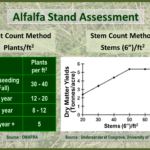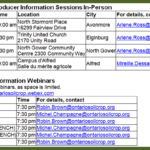Conditions: Below average temperatures persisted throughout most of April. At Ottawa, approximately 100 CHU and 65 mm of rain were accumulated in April. Soils dried slowly and field activity only picked up during the last few days of April.
Forages: Alfalfa winter survival is excellent, generally in the 90% plus range. Alfalfa fields not harvested last fall have about 3” of new growth, while fields harvested last fall have about 2” of growth. Nitrogen recommendations for grass stands: productive grass stands: 50 lbs of nitrogen per tonne of expected forage dry matter yield per acre (e.g. 2 tonnes of DM = 100 lbs/acre of N); grass stands with 1/3 to 1/2 legumes: 60 lbs of nitrogen per acre; unimproved grass pastures: 50 lbs of nitrogen per acre.
The combination of excellent alfalfa winter survival and high stored forage inventories is providing an excellent opportunity to rotate weaker stands to other crops and take advantage of the nitrogen credit from alfalfa and the 10 – 15% rotational yield benefit in the subsequent crop. For alfalfa stand assessment (Figure 1.) information visit: http://bit.ly/1P9VO7F.
Figure 1. Alfalfa Stand Assessment
Key for successful new seeding establishment: seed early, ensure soil fertility is adequate (consider applying starter fertilizer where possible), seed into a firm seedbed (pack before and after seeding if needed), place the seed at a uniform depth of ¼ to ½ inch and control weeds early (for broadleaf weed: 1st – 2nd trifoliate stage of alfalfa). More information available at: 5 Forage Establishment Mistakes To Avoid http://bit.ly/1Jbos6v and Successful Forage Establishment http://bit.ly/1DEk9f8.
Winter Wheat: Winter survival is generally good, but variable. Some stands are struggling and will need to be rotated. A few days of warm weather will make stand assessment easier. To determine yield potential for various plant counts see Evaluating Winter Wheat Plant Stands at http://bit.ly/1EFpp7q.
Spring Cereals: Little planting progress to date. Seed supply remains very tight. Concern over geese feeding damage in winter and spring wheat was expressed. Figure 2 summarises the results of a geese feeding trial, where a lawn mower was used to simulate feeding damage over various periods of time. Spring geese management information and permit application forms are available from Environment Canada at http://bit.ly/10zjb28.
Figure 2. Geese Feeding Simulation Trial
Corn: Very little planting progress to date.
Proposed neonicotinoid regulation: Industry is encouraging anyone impacted by the proposed regulation to read the proposed regulation and consider responding to the public consultation process before the May 7th deadline. See the links below for information and to provide comments.
Regulation Proposal Notice: http://bit.ly/1PN56bU
New Regulatory Requirements – explained: http://bit.ly/1EePl8x
Conducting a Pest Assessment for Class 12 Pesticides: http://bit.ly/1bwOBRW
Avian Influenza: Information on biosecurity protocols to minimize the risk of Avian influenza virus spread is posted at: http://bit.ly/1AkCyNV (Cropline Show Notes – April 23, 2015) and http://bit.ly/1FzNTja (Avian Influenza: Manure Application and Crop Production BMPs).
Growing Forward 2 Producer Information Sessions:
Field Crop News Website – https://fieldcropnews.com/
Important Date:
July 21 – Eastern Ontario Crop Diagnostic Day, Winchester Research Farm.
Next meeting:
7:30 am, May 12th, Country Kitchen Restaurant, Highway 31, Winchester, ON.



